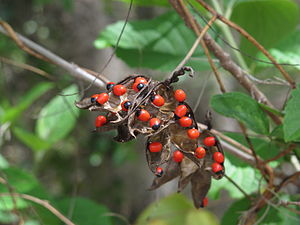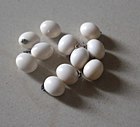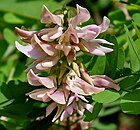Note: This is a project under development. The articles on this wiki are just being initiated and broadly incomplete. You can Help creating new pages.
Difference between revisions of "Abrus precatorius - Gunja"
m (Prabhakar moved page Gunja to Gunja (Abrus Precatorius)) |
(→References) |
||
| (116 intermediate revisions by 3 users not shown) | |||
| Line 1: | Line 1: | ||
| − | [[File: | + | [[File:Abrus_precatorius_%E2%80%94_Scott_Zona_001.jpg|thumb|right]] |
| − | + | '''Abrus precatorius''' is a severely invasive plant in warm temperate to tropical regions. The plant is best known for its seeds, which are used as beads and in percussion instruments and which are toxic because of the presence of abrin. This plant belongs to Fabaceae family. | |
| + | ==Uses== | ||
| + | {{Uses|Blisters in mouths}}, {{Uses|Mouth sores}}, {{Uses|Bleeding piles}}, {{Uses|Leucorrhoea}}, {{Uses|Mild diabetes}}, {{Uses|Cough}}, {{Uses|Physical weakness}}, {{Uses|Ulcer}}, {{Uses|Urinary trouble}}, {{Uses|Snakebite}}, {{Uses|Infection in intestine}}.<ref name="Uses"/> | ||
| + | ===Food=== | ||
| + | Gunja can be used in food. Leaves are sweet and are chewed with paan or also eaten raw<ref name="Forest foods of Western Ghat"/> | ||
| − | + | ==Parts Used== | |
| + | {{Parts Used|Seeds}}, {{Parts Used|Stem}}, {{Parts Used|Leaves}}, {{Parts Used|Roots}}<ref name="Forest foods of Western Ghat"/> | ||
| − | + | ==Chemical Composition== | |
| − | + | Mature seeds contain alkali like abrine, precatorine, etc.<ref name="chemical composition"/> | |
| − | |||
| − | |||
| − | ==Common | + | ==Common names== |
| + | {{Common names|kn=Gulaganji, ಗುಲಗಂಜಿ|ml=Kunni, Kunnikkuru|sa=Gunja|ta=Gundumani, Kundumani|te=Gurivinda|hi=Gaungchi, Gunchi|en=Equirity}} | ||
| − | + | ==Properties== | |
| − | + | Reference: Dravya - Substance, Rasa - Taste, Guna - Qualities, Veerya - Potency, Vipaka - Post-digesion effect, Karma - Pharmacological activity, Prabhava - Therepeutics. | |
| − | + | ===Dravya=== | |
| − | + | ===Rasa=== | |
| − | == | + | Tikta (Bitter), Kashaya (Astringent) |
| + | ===Guna=== | ||
| + | Laghu (Light), Ruksha (Dry) | ||
| + | ===Veerya=== | ||
| + | Ushna (Hot) | ||
| + | ===Vipaka=== | ||
| + | Katu (Pungent) | ||
| + | ===Karma=== | ||
| + | Kapha, Vata | ||
| + | ===Prabhava=== | ||
| − | + | ===Nutritional components=== | |
| + | Gunja contains the Following nutritional components like Vitamin A Vitamin A, B, C; Calcium, Magnesium, Phosphorus, Potassium, Sodium, Zinc etc.<ref name="Forest foods of Western Ghat"/> | ||
| − | [[ | + | ==Habit== |
| + | {{Habit|Deciduous climber}} | ||
| + | |||
| + | ==Identification== | ||
| + | ===Leaf=== | ||
| + | {{Leaf|Paripinnate|Obovate|Leaves are alternately arranged, leaflets 12-16 pairs, 0.8-2.5 x 0.4-1 cm, oblong to elliptic, base and apex obtuse}}<ref name="Leaf"/> | ||
| + | |||
| + | ===Flower=== | ||
| + | {{Flower|Bisexual|2-4cm long|Pink/white|9|Flowering through out the year}}<ref name="Identification"/> | ||
| + | |||
| + | ===Fruit=== | ||
| + | {{Fruit|Oblong pod|Thinly septate|Pilose, wrinkled|Subglobose|Seeds upto 5|Fruiting through out the year}}<ref name="Identification"/> | ||
| + | |||
| + | ==List of Ayurvedic medicine in which the herb is used== | ||
| + | * [[Neelibhrungadi tailam]] as ''root juice extract'' | ||
| + | * [[Sarivadi Vati]] as ''root juice extract'' | ||
| + | <ref name="Ayurvedic preparations"/> | ||
| + | |||
| + | ==Where to get the saplings== | ||
| + | |||
| + | ==Mode of Propagation== | ||
| + | {{Propagation|Seeds}}, {{Propagation|Cuttings}} | ||
| + | |||
| + | ==Cultivation Details== | ||
| + | Seeds naturally have a low germination rate. The hard and impenetrable seed coat is one of the reasons. Gunja's availability period is from August to March<ref name="Cultivation details"/><ref name="Forest foods of Western Ghat"/> | ||
| + | |||
| + | ==Season to grow== | ||
| + | |||
| + | |||
| + | ==Required Ecosystem/Climate== | ||
| + | |||
| + | |||
| + | ==Kind of soil needed== | ||
| + | |||
| + | |||
| + | ==Commonly seen growing in areas== | ||
| + | {{Commonly seen|Tropical area}}, {{Commonly seen|Subtropical area}}. | ||
| + | |||
| + | ==Photo Gallery== | ||
| + | <gallery class="left" caption="" widths="140px" heights="140px"> | ||
| + | File:AbrusWhiteSeeds.jpg|White variety of seeds. | ||
| + | File:Abrus precatorius W IMG 1578.jpg|''Abrus precatorius'' leaves and flowers | ||
| + | File:Abrus precatorius W2 IMG 1578.jpg|''Abrus precatorius'' flowers | ||
| + | File:IndianLicorice 7899.JPG|''Abrus precatorius'' seeds | ||
| + | File:Abrus_precatorius_%E2%80%94_Scott_Zona_001.jpg|Fruits | ||
| + | </gallery> | ||
| + | |||
| + | ==References== | ||
| + | <references> | ||
| + | <ref name="chemical composition">[https://web.archive.org/web/20130728111350/http://libproject.hkbu.edu.hk/was40/detail?lang=en&channelid=1288&searchword=herb_id%3DD01344 Chemistry]</ref> | ||
| + | <ref name="Leaf">[https://indiabiodiversity.org/species/show/32002 Morphology]</ref> | ||
| + | <ref name="Ayurvedic preparations">[https://easyayurveda.com/2015/09/12/rosary-pea-abrus-precatorius/ Ayurvedic preparations]</ref> | ||
| + | <ref name="Cultivation details">[https://www.researchgate.net/post/How_to_cultivate_Abrus_precatorius Cultivation details]</ref> | ||
| + | <ref name="Uses">Karnataka Aushadhiya Sasyagalu By Dr.Maagadi R Gurudeva, Page no:121</ref> | ||
| + | <ref name="Identification">Kappathagudda - A Repertoire of Medicinal Plants of Gadag book, Page no: 30</ref> | ||
| + | <ref name="Forest foods of Western Ghat">"Forest food for Northern region of Western Ghats" by Dr. Mandar N. Datar and Dr. Anuradha S. Upadhye, Page No.15, Published by Maharashtra Association for the Cultivation of Science (MACS) Agharkar Research Institute, Gopal Ganesh Agarkar Road, Pune</ref> | ||
| + | </references> | ||
| + | |||
| + | ==External Links== | ||
| + | * [https://www.bimbima.com/ayurveda/gunja-jequirity-information-and-medicinal-uses/197/ Gunja (Jequirity) Information and Medicinal Uses] | ||
| + | * [https://www.dabur.com/in/en-us/about/science-of-ayurveda/herbal-medicinal-plants/rati-plant Gunja on medicinal plants ] | ||
| + | * [https://easyayurveda.com/2015/09/12/rosary-pea-abrus-precatorius/ Gunja-purification and side efffects] | ||
| + | * [http://www.planetayurveda.com/abrus_precatorius.htm Gunja-medicinal uses and benefits] | ||
| + | * [http://medicinal-plant-abrus.blogspot.in/ Medicinal Plant - Abrus precatorius] | ||
| + | |||
| + | [[Category:Herbs]] | ||
| + | [[Category:Climber]] | ||
| + | [[Category:Fabaceae]] | ||
Latest revision as of 15:18, 21 October 2021
Abrus precatorius is a severely invasive plant in warm temperate to tropical regions. The plant is best known for its seeds, which are used as beads and in percussion instruments and which are toxic because of the presence of abrin. This plant belongs to Fabaceae family.
Contents
- 1 Uses
- 2 Parts Used
- 3 Chemical Composition
- 4 Common names
- 5 Properties
- 6 Habit
- 7 Identification
- 8 List of Ayurvedic medicine in which the herb is used
- 9 Where to get the saplings
- 10 Mode of Propagation
- 11 Cultivation Details
- 12 Season to grow
- 13 Required Ecosystem/Climate
- 14 Kind of soil needed
- 15 Commonly seen growing in areas
- 16 Photo Gallery
- 17 References
- 18 External Links
Uses
Blisters in mouths, Mouth sores, Bleeding piles, Leucorrhoea, Mild diabetes, Cough, Physical weakness, Ulcer, Urinary trouble, Snakebite, Infection in intestine.[1]
Food
Gunja can be used in food. Leaves are sweet and are chewed with paan or also eaten raw[2]
Parts Used
Chemical Composition
Mature seeds contain alkali like abrine, precatorine, etc.[3]
Common names
| Language | Common name |
|---|---|
| Kannada | Gulaganji, ಗುಲಗಂಜಿ |
| Hindi | Gaungchi, Gunchi |
| Malayalam | Kunni, Kunnikkuru |
| Tamil | Gundumani, Kundumani |
| Telugu | Gurivinda |
| Marathi | NA |
| Gujarathi | NA |
| Punjabi | NA |
| Kashmiri | NA |
| Sanskrit | Gunja |
| English | Equirity |
Properties
Reference: Dravya - Substance, Rasa - Taste, Guna - Qualities, Veerya - Potency, Vipaka - Post-digesion effect, Karma - Pharmacological activity, Prabhava - Therepeutics.
Dravya
Rasa
Tikta (Bitter), Kashaya (Astringent)
Guna
Laghu (Light), Ruksha (Dry)
Veerya
Ushna (Hot)
Vipaka
Katu (Pungent)
Karma
Kapha, Vata
Prabhava
Nutritional components
Gunja contains the Following nutritional components like Vitamin A Vitamin A, B, C; Calcium, Magnesium, Phosphorus, Potassium, Sodium, Zinc etc.[2]
Habit
Identification
Leaf
| Kind | Shape | Feature |
|---|---|---|
| Paripinnate | Obovate | Leaves are alternately arranged, leaflets 12-16 pairs, 0.8-2.5 x 0.4-1 cm, oblong to elliptic, base and apex obtuse |
Flower
| Type | Size | Color and composition | Stamen | More information |
|---|---|---|---|---|
| Bisexual | 2-4cm long | Pink/white | 9 | Flowering through out the year |
Fruit
| Type | Size | Mass | Appearance | Seeds | More information |
|---|---|---|---|---|---|
| Oblong pod | Thinly septate | Pilose, wrinkled | Subglobose | Seeds upto 5 | Fruiting through out the year |
List of Ayurvedic medicine in which the herb is used
- Neelibhrungadi tailam as root juice extract
- Sarivadi Vati as root juice extract
Where to get the saplings
Mode of Propagation
Cultivation Details
Seeds naturally have a low germination rate. The hard and impenetrable seed coat is one of the reasons. Gunja's availability period is from August to March[7][2]
Season to grow
Required Ecosystem/Climate
Kind of soil needed
Commonly seen growing in areas
Tropical area, Subtropical area.
Photo Gallery
References
- ↑ Karnataka Aushadhiya Sasyagalu By Dr.Maagadi R Gurudeva, Page no:121
- ↑ 2.0 2.1 2.2 2.3 "Forest food for Northern region of Western Ghats" by Dr. Mandar N. Datar and Dr. Anuradha S. Upadhye, Page No.15, Published by Maharashtra Association for the Cultivation of Science (MACS) Agharkar Research Institute, Gopal Ganesh Agarkar Road, Pune
- ↑ Chemistry
- ↑ Morphology
- ↑ 5.0 5.1 Kappathagudda - A Repertoire of Medicinal Plants of Gadag book, Page no: 30
- ↑ Ayurvedic preparations
- ↑ Cultivation details
External Links
- Ayurvedic Herbs known to be helpful to treat Blisters in mouths
- Ayurvedic Herbs known to be helpful to treat Mouth sores
- Ayurvedic Herbs known to be helpful to treat Bleeding piles
- Ayurvedic Herbs known to be helpful to treat Leucorrhoea
- Ayurvedic Herbs known to be helpful to treat Mild diabetes
- Ayurvedic Herbs known to be helpful to treat Cough
- Ayurvedic Herbs known to be helpful to treat Physical weakness
- Ayurvedic Herbs known to be helpful to treat Ulcer
- Ayurvedic Herbs known to be helpful to treat Urinary trouble
- Ayurvedic Herbs known to be helpful to treat Snakebite
- Ayurvedic Herbs known to be helpful to treat Infection in intestine
- Herbs with Seeds used in medicine
- Herbs with Stem used in medicine
- Herbs with Leaves used in medicine
- Herbs with Roots used in medicine
- Herbs with common name in Kannada
- Herbs with common name in Hindi
- Herbs with common name in Malayalam
- Herbs with common name in Tamil
- Herbs with common name in Telugu
- Herbs with common name in Sanskrit
- Herbs with common name in English
- Habit - Deciduous climber
- Index of Plants which can be propagated by Seeds
- Index of Plants which can be propagated by Cuttings
- Herbs that are commonly seen in the region of Tropical area
- Herbs that are commonly seen in the region of Subtropical area
- Herbs
- Climber
- Fabaceae





